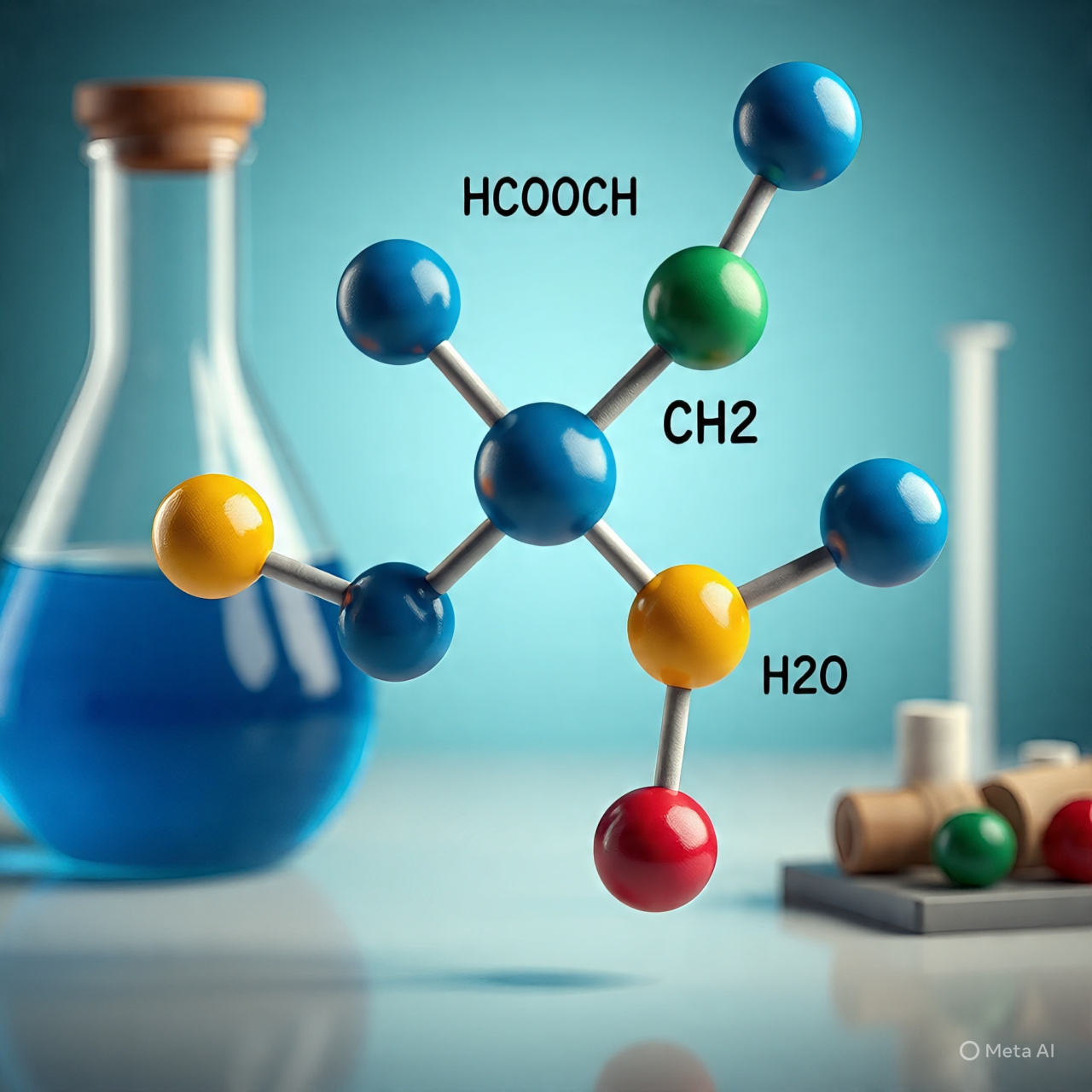In the field of organic chemistry, molecular formulas and reaction representations play a crucial role in understanding the transformation of substances. One such compound notation is “HCOOCH CH2 H2O“, which appears cryptic to those unfamiliar with organic reaction mechanisms. This article will break down this keyword, interpret its scientific context, and explain its significance in organic chemistry.
We’ll explore the components of this expression, possible reactions it may be associated with, its relevance in laboratory and industrial chemistry, and provide answers to frequently asked questions about “hcooch ch2 h2o”.
What is “HCOOCH CH2 H2O”?
To begin, let’s deconstruct the keyword “hcooch ch2 h2o” into its chemical parts. While it may initially appear as a typo or an incorrectly written chemical equation, with careful interpretation, it starts to make sense within the realm of organic ester hydrolysis or condensation reactions.
Breaking It Down
- HCOOCH: This likely refers to methyl formate, also written more clearly as HCOOCH₃. It is an ester formed from formic acid (HCOOH) and methanol (CH₃OH).
- CH2: This unit could refer to a methylene group (-CH₂-) which is common in organic structures, though by itself, it needs context.
- H2O: Water, a universal solvent and often a reagent in hydrolysis reactions.
When combined as HCOOCH₃ + H₂O, it strongly suggests a hydrolysis reaction of methyl formate. The inclusion of CH₂ in the middle of the notation could hint at a side group or an intermediate step involving a carbon chain.
The Chemistry Behind HCOOCH₃ + H₂O
Let’s assume the correct interpretation of hcooch ch2 h2o is methyl formate hydrolysis, potentially involving a methylene group (CH₂) from a compound like ethylene glycol or formaldehyde derivatives. But for simplicity and clarity, we’ll focus on the basic reaction:
Hydrolysis of Methyl Formate
Methyl Formate (HCOOCH₃) can undergo acid- or base-catalyzed hydrolysis with water (H₂O) to produce: HCOOCH3+H2O→HCOOH+CH3OH\text{HCOOCH}_3 + \text{H}_2\text{O} \rightarrow \text{HCOOH} + \text{CH}_3\text{OH}HCOOCH3+H2O→HCOOH+CH3OH
- HCOOH (Formic Acid) – a simple carboxylic acid
- CH₃OH (Methanol) – a basic alcohol
This is a typical ester hydrolysis reaction, also known as ester cleavage, common in both industrial and biological chemistry.
Industrial Significance of the Reaction
Understanding the hydrolysis of esters like methyl formate is key in several chemical manufacturing processes.
Applications
- Chemical Synthesis: Produces essential intermediates such as formic acid and methanol.
- Pharmaceuticals: Ester hydrolysis is part of drug metabolism.
- Perfume and Flavor Industry: Esters contribute to fragrances; their hydrolysis alters scent profiles.
- Plastic and Resin Production: Formic acid is used in making resins and plasticizers.
Organic Chemistry Concepts Involved
Esterification and Hydrolysis
In organic chemistry, esterification is the reaction of a carboxylic acid with an alcohol to form an ester and water: HCOOH+CH3OH↔HCOOCH3+H2O\text{HCOOH} + \text{CH}_3\text{OH} \leftrightarrow \text{HCOOCH}_3 + \text{H}_2\text{O}HCOOH+CH3OH↔HCOOCH3+H2O
This is an equilibrium reaction. Conversely, hydrolysis breaks the ester back into its original acid and alcohol.
Role of Catalysts
Acids (like HCl or H₂SO₄) or bases (like NaOH) are often used to accelerate ester hydrolysis:
- Acidic Hydrolysis: Reversible
- Basic Hydrolysis (Saponification): Irreversible
Exploring CH₂ in the Reaction Context
The presence of CH₂ in the keyword raises questions. Is it a bridge between two molecules? Could it be part of a compound like ethylene glycol (HOCH₂CH₂OH)?
Possible Reactions Involving CH₂
- Formaldehyde Derivatives: CH₂ could represent formaldehyde, which reacts with alcohols to form acetals.
- Polymers: Methylene groups are building blocks in polymers like polyethylene.
- Side Reactions: CH₂ may also appear in intermediates or transition states during complex esterification reactions.
However, without further clarification, CH₂ remains ambiguous in this context and is likely a formatting artifact in the keyword. The primary focus stays on HCOOCH₃ + H₂O.
Real-Life Examples and Laboratory Relevance
Experiment: Hydrolysis of Methyl Formate
Objective: Demonstrate ester hydrolysis and observe product formation.
Materials:
- Methyl Formate
- Water
- Hydrochloric Acid (catalyst)
- pH indicator
Procedure:
- Mix methyl formate with water in a beaker.
- Add a few drops of HCl.
- Stir and warm the solution.
- Observe pH change and test for methanol via chromic acid test.
Expected Outcome: The solution becomes acidic (formic acid) and shows presence of alcohol.
Environmental and Safety Considerations
Toxicity of Methyl Formate
- Toxic if inhaled in high concentrations
- Flammable: Requires safe handling
- Environmental impact: Moderate, breaks down rapidly
Water as a Green Solvent
Using water in hydrolysis reactions is environmentally friendly, aligning with green chemistry principles.
Educational Importance
Teaching Organic Reactions
The “hcooch ch2 h2o” keyword offers educators a way to introduce:
- Esters and their properties
- Reaction mechanisms (nucleophilic substitution)
- Functional group transformations
- Real-world applications of chemistry
Common Misinterpretations of the Keyword
Given its format, “hcooch ch2 h2o” may be misread due to lack of proper notation. Here’s what it does not represent:
- Not a complete reaction unless assumed to be ester hydrolysis
- CH₂ is vague unless contextualized
- Could be a typographic shorthand or chemical software artifact
Related Concepts
Functional Groups Involved
- Ester (-COO-)
- Hydroxyl (-OH)
- Carboxyl (-COOH)
Key Reaction Types
- Nucleophilic acyl substitution
- Reversible reactions
- Acid/base catalysis
FAQs about HCOOCH CH2 H2O
Q1: What does “hcooch ch2 h2o” stand for?
A: It likely represents a chemical reaction involving methyl formate (HCOOCH₃) and water (H₂O), possibly hydrolyzing into formic acid and methanol. The CH₂ may reference a methylene group, although unclear without more context.
Q2: Is HCOOCH a real compound?
A: Yes, when properly notated as HCOOCH₃, it stands for methyl formate, an ester derived from formic acid and methanol.
Q3: What is the purpose of adding water (H₂O) in such reactions?
A: Water is used to hydrolyze esters, breaking them into their acid and alcohol components. It’s essential in reversing esterification.
Q4: What is formed when HCOOCH₃ reacts with water?
A: Formic acid (HCOOH) and methanol (CH₃OH) are produced.
Q5: Is this reaction used in industry?
A: Yes, especially in the production of solvents, preservatives, and intermediates in chemical synthesis.
Q6: What role does CH₂ play in the reaction?
A: CH₂ could reference a structural group in a larger molecule, but in this keyword, it might be a misnotation or irrelevant without a full molecular context.
Q7: Is this reaction reversible?
A: Yes, in acid-catalyzed conditions. In base-catalyzed hydrolysis (saponification), it becomes irreversible.
Q8: Is methyl formate dangerous?
A: Methyl formate is flammable and can be toxic in large quantities. It must be handled with care in well-ventilated labs.
Conclusion
Understanding such notations is essential for students, researchers, and professionals dealing with chemical synthesis, industrial processes, or environmental chemistry. From its reaction mechanism to its practical uses, “hcooch ch2 h2o” embodies the core of functional group chemistry and organic transformation.



